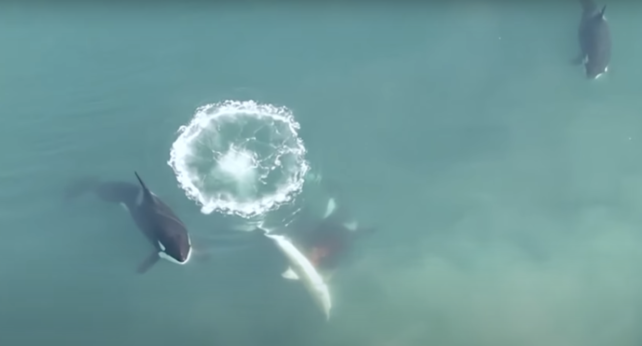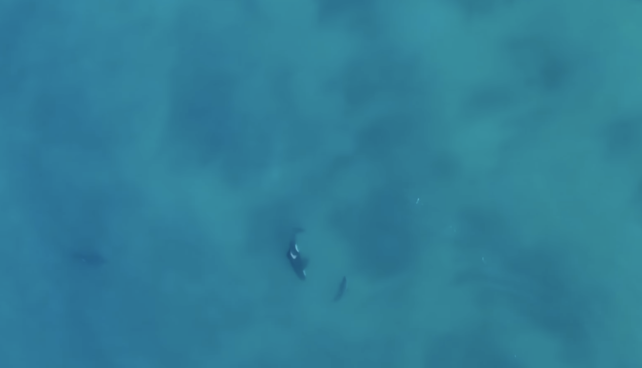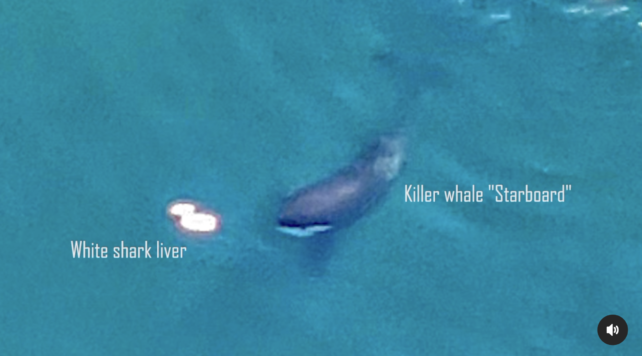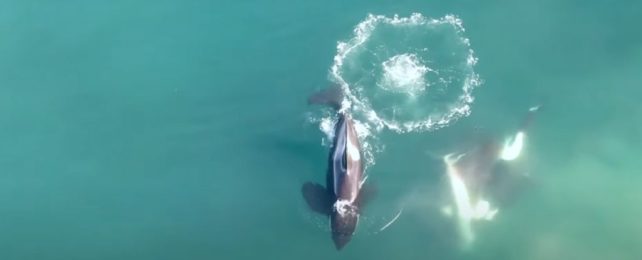Great white sharks have been strangely absent off the coast of South Africa in recent years, with suspicions for their decline falling onto that other most notorious oceanic predator, the orca.
Now there's footage of an actual hunt in action.
Two new observations, one from a helicopter and one from a drone, have captured two of the ocean's fiercest predators facing off in a world first.
"This behavior has never been witnessed in detail before, and certainly never from the air," says marine scientist Alison Towner from Rhodes University in South Africa.
In the harbor of Mossel Bay on the afternoon of 16 May, a drifting drone caught sight of a white belly in the blue. A handful of killer whales were swimming near the surface, and the drone pilot – a hobbyist on the beach – decided to track them.
As the drone followed and recorded the group, a pair of orcas split eastward towards the local river's mouth – a known hotspot for shark activity.
Two of the remaining cetaceans began swimming close together on the ocean's surface, facing opposite directions, as though they were keeping a look out.
Seven seconds later, a fifth orca emerged from the deep right between the two patrols. Its nose was pushing a three-meter-long white shark, belly-side up, to the surface. With a quick flip, the orca rolled the shark on its side and bit into its belly behind its pectoral fin, blood spilling into the sea.
With the shark clasped firmly in the orca's jaws, the fifth individual dove deep once more, releasing the carcass as it went.
One of the patrolling orcas then approached and grabbed the shark's tail, pulling the once mighty hunter into the abyss, never to be seen again.
An individual in the group of orcas was later identified as 'Starboard', a famous male with a collapsed dorsal fin. Starboard has previously been implicated in a series of washed-up shark carcasses found on South Africa's beaches, four of which were missing their livers.
No one has ever caught Starboard in direct battle with a great white shark before, but circumstantial evidence suggests he and another male orca, named Port, are the likely killers of other local shark species. These two whales often frequent shark hotspots, and when they visit, the large fish tend to abandon the area for days.
"I first saw Starboard in 2015 when he and his close-associated 'Port' were linked to killing seven gill sharks in False Bay," says David Hurwitz, a boat-based whale-watching operator from Simon's Town Boat Company, who contributed to the study.
"We saw them kill a bronze whaler [copper shark] in 2019 – but this new observation is really something else."

Orcas are known to occasionally hunt white sharks, but only three studies have ever formally described such a battle.
A formal analysis of the drone's footage and snaps from a local helicopter are the first to show the hunting strategy in any detail.
The helicopter photographs suggest at least two other white sharks were also killed by orcas near Mossel Bay on that same, fateful day.
Just before the drone footage, the helicopter's pilot witnessed two shark killings from the air.
With their phone, the pilot managed to snap a series of images and short video clips of the orca predators.

"Given the overlap in time and area, we assume it is the same group captured by the drone footage," the researchers write.
"Two video sequences at 14h 07 and 14h 27 showed two different killer whales (Starboard in the first clip) closely following large white sharks at <1 killer whale body length. In both clips, the sharks displayed evasive behaviors, circling back tightly with the whale following, but both moving slowly."
This circling technique is probably a shark's way of keeping an eye on an orca. It's similar to how their own prey avoid them. While sharks occasionally team up to hunt, orcas have it down to a fine art, which means looking in one direction is no guarantee of safety.
From the helicopter, the pilot snapped photos of one of the orcas chowing down on what looks like a huge shark liver, one the size of an orca's head. This suggests that a white shark's liver is buoyant, which means the fatty meal could drift to the surface following a big bite to a shark's belly.

Four minutes before the feeding event, beach-based observers and the drone pilot reported seeing sharks fleeing the area. Some even came in to shore as shallow as two meters.
That day, ten sharks had been observed from the drone. But for weeks after the killing spree, hardly any sharks were seen in the area, based on satellite tags, drone surveys, and boat sightings.
The fact that Starboard, an older male orca, has now been caught hunting white sharks with a different pod of orcas suggests that the behavior may be spreading.
If more orcas adopt the practice, then it could have a serious impact on local shark populations, which are treasured and respected in Mossel Bay.
Fewer sightings of sharks off the coast have led some to blame illegal hunting activities and overfishing for their absence. But that might not be true after all.
The study was published in Ecology.
